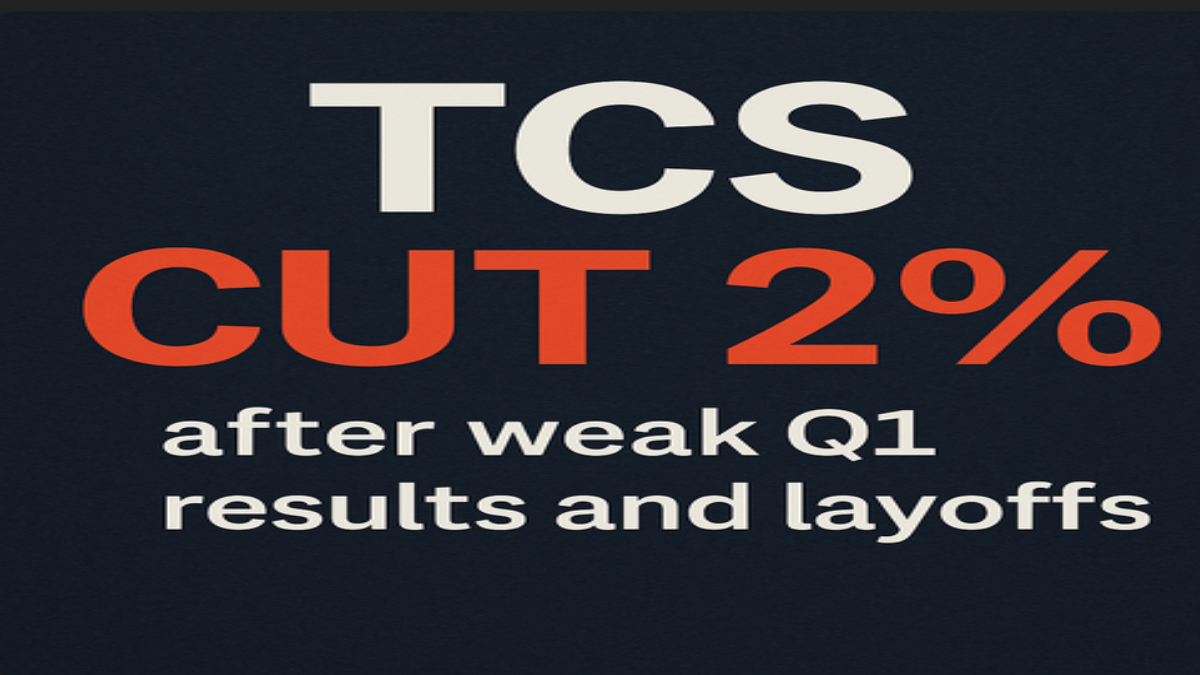Overview: TCS Shares Drops ~2% after Q1 FY26 Earnings Miss
Shares of Tata Consultancy Services (TCS) declined around 1.8% to 2% in early trade on July 11, 2025, reacting to softer-than-expected Q1 FY26 results and a cautious outlook.
Investors remain concerned as the broader Nifty IT index dropped over 1%, led by underperformance across major IT firms like TCS, Infosys, HCLTech, and Tech Mahindra.

Q1 FY26 Financials: Growth Was Below Expectations
Key Metrics:
| Metric | Q1 FY26 | YoY Growth |
|---|---|---|
| Net Profit | ₹12,760 Cr | +6% (vs ₹12,040 Cr) |
| Revenue | ₹63,437 Cr | +1.3% YoY; –3.1% in constant currency |
| Dividend | Interim ₹11/share; record date: July 16, payment: Aug 4 |
- While the net profit exceeded expectations, revenue growth remained sluggish, primarily due to a steep drop in domestic business revenue led by the BSNL contract ramp-down.
Net profit beat estimates but revenue growth slowed, particularly in constant currency terms.

Why Did TCS Shares Fall?
Weak Constant Currency Growth
The company reported a 3.1% decline in revenue in constant currency, missing analyst expectations. This was primarily due to delays in deal execution and subdued client spending in key markets.
Domestic Business Drag
TCS management confirmed that the ramp-down of the BSNL deal alone contributed to 85% of the overall revenue decline this quarter.
Global Headwinds
TCS CEO K. Krithivasan pointed to ongoing macroeconomic challenges, especially in the U.S. and Europe, where tech budgets have shrunk amid geopolitical tensions.
Strategic Layoffs
In a significant move, TCS announced the layoff of 2% of its workforce, impacting over 12,000 employees, mainly at mid- and senior levels. The restructuring aligns with its long-term AI, cloud, and automation focus.
Sector-Wide Impact & Sentiment
The weak TCS results triggered a sector-wide sell-off. Indian IT shares declined up to 2%, leading the Nifty IT index to underperform the broader market. Investors responded to downgraded growth forecasts and macro concerns.
TCS Fundamentals Remain Strong Long-Term
Solid Growth Over 5 Years
From FY21 to FY25, TCS delivered consistent growth with revenue rising from ₹164,177 Cr to ₹255,324 Cr; net profit grew similarly from ₹32,562 Cr to ₹48,797 Cr. EPS rose from ₹86.71 to ₹134.19; RoE surpassed 50%—and the company remains nearly debt‑free.
Valuation & Brand Strength
At a P/E of ~27x and P/B of ~13–15x, TCS trades at a premium but commands strong brand equity, digital capability, and a global order pipeline.
What Investors Should Monitor
Macro-Economic & Trade Developments
Global trade uncertainties and U.S. tariff policies impact discretionary IT budgets in TCS’s key markets.
Upcoming Q2 Earnings
Watch for improved revenue momentum, stable margins, and clarity on deal wins converting into revenue.
Workforce Strategy
Layoffs and strict benching policies signal tighter cost controls; employee morale and execution capability remain key.
Analyst Action
Brokerages like JM Financial continue to view TCS favorably with conservative target revisions around ₹3,950/share.
What to Watch Going Ahead
- Q2 FY26 Results: Can TCS bounce back on deal execution?
- Employee Restructuring: Will layoffs affect performance and morale?
- Order Conversion: Can TCS convert its $9.4 billion deal wins into strong revenue?
- Global Economic Recovery: As U.S. and EU markets stabilize, IT demand may revive.
Investment Outlook: Short vs. Long Term
Short-Term Traders
Expect near-term volatility due to earnings miss and sector drag. Support lies near ₹3,300; resistance in ₹3,350–3,400 zone.
Long-Term Investors
TCS remains a high-quality compounder with strong fundamentals and resilient margins. Weakness is likely cyclical—appeals to those focusing on digital transformation and dividend income.
Summary: Gain or Pain?
Despite the 2% dip, TCS’s fundamentals remain intact. Revenue softness appears temporary and tied to specific client ramp-downs. Strong order pipeline, diversification, and AI capabilities support a cautious long-term bullish thesis. Near term may see modest headwinds, but quality investors likely view this as an opportunity, not a downturn.
Disclaimer: This article is for informational purposes only and does not constitute investment advice. Investors should conduct their own research and consult with a qualified financial advisor before making investment decisions. The author does not hold any positions in the securities mentioned.